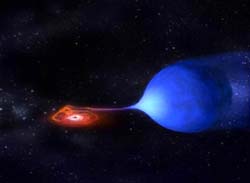Scientists Watch "Movie"Of Neutron Star Explosion In Real-Time

Credit: NASA/Dana Berry <br>
Scientists at the Canadian Institute for Theoretical Astrophysics (CITA) and NASA have captured unprecedented details of the swirling flow of gas hovering just a few miles from the surface of a neutron star, itself a sphere only about ten miles across.
A massive and rare explosion on the surface of this neutron star – pouring out more energy in three hours than the Sun does in 100 years – illuminated the area and allowed the scientists to spy on details of the region never before revealed. They could see details as fine as the ring of gas swirling around and flowing onto the neutron star as this ring buckled from the explosion and then slowly recovered its original form after approximately 1,000 seconds.
All of this was occurring 25,000 light years from Earth, captured second-by-second in movie-like fashion through a process called spectroscopy with NASA’s Rossi X-ray Timing Explorer.
Dr. David Ballantyne of CITA at the University of Toronto and Dr. Tod Strohmayer of NASA’s Goddard Space Flight Center in Greenbelt, Md., present this result in an upcoming issue of Astrophysical Journal Letters. The observation provides new insight into the flow of a neutron star’s (and perhaps a black hole’s) “accretion disk,” usually far too minute to resolve with even the most powerful telescopes.
“This is the first time we have been able to watch the inner regions of an accretion disk, in this case literally a few miles from the neutron star’s surface, change its structure in real-time,” said Ballantyne. “Accretion disks are known to flow around many objects in the Universe, from newly forming stars to the giant black holes in distant quasars. Details of how such a disk flows could only be inferred up to now.”
A neutron star is the dense, core remains of an exploded star at least eight times more massive than the Sun. The neutron star contains about a sun’s worth of mass packed in a sphere no larger than Toronto. An accretion disk refers to the flow of hot gas (plasma) swirling around neutron stars and black holes, attracted by the strong gravity of the region. This gas is often supplied by a neighboring star.
As matter crashes down on the neutron star it builds up a 10- to 100-meter layer of material comprised mostly of helium. The fusion of the helium into carbon and other heavier elements releases enormous energy and powers a strong burst of X-ray light, far more energetic than visible light. (Nuclear fusion is the same process that powers the Sun.) Such bursts can occur several times a day on a neutron star and last for about 10 seconds.
What Ballantyne and Strohmayer observed on this neutron star, named 4U 1820-30, was a “superburst”. These are much more rare than ordinary, helium-powered bursts and release a thousand times more energy. Scientists say these superbursts are caused by a buildup of nuclear ash in the form of carbon from the helium fusion. Current thinking suggests that is takes several years for the carbon ash to buildup to such an extent that it begins to fuse.
The superburst was so bright and long that it acted like a spotlight beamed from the neutron star surface and onto the innermost region of the accretion disk. The X-ray light from the burst illuminated iron atoms in the accretion disk, a process called fluorescence. The Rossi Explorer captured the characteristic signature of the iron fluorescence — that is, its spectrum. This, in turn, provided information about the iron’s temperature, velocity and location around the neutron star.
“The Rossi Explorer can get a good measurement of the fluorescence spectrum of the iron atoms every few seconds,” Strohmayer said. “Adding up all this information, we get a picture of how this accretion disk is being deformed by the thermonuclear blast. This is the best look we can hope to get, because the resolution needed to actually see this action as an image, instead of spectra, would be a billion times greater than what the Hubble Space Telescope offers.”
The scientists said the bursting neutron stars serve as a laboratory to study accretion disks, which are seen (but in less detail) through the Universe around nearby stellar black holes and exceedingly distant quasar galaxies. Stellar black holes with accretion disks do not produce X-ray bursts.
The Rossi Explorer was launched in December 1995 to observe fast-changing, energetic and rapidly spinning objects, such as supermassive black holes, active galactic nuclei, neutron stars and millisecond pulsars.
Media Contact
More Information:
http://www.newsandevents.utoronto.ca/All latest news from the category: Physics and Astronomy
This area deals with the fundamental laws and building blocks of nature and how they interact, the properties and the behavior of matter, and research into space and time and their structures.
innovations-report provides in-depth reports and articles on subjects such as astrophysics, laser technologies, nuclear, quantum, particle and solid-state physics, nanotechnologies, planetary research and findings (Mars, Venus) and developments related to the Hubble Telescope.
Newest articles

First-of-its-kind study uses remote sensing to monitor plastic debris in rivers and lakes
Remote sensing creates a cost-effective solution to monitoring plastic pollution. A first-of-its-kind study from researchers at the University of Minnesota Twin Cities shows how remote sensing can help monitor and…

Laser-based artificial neuron mimics nerve cell functions at lightning speed
With a processing speed a billion times faster than nature, chip-based laser neuron could help advance AI tasks such as pattern recognition and sequence prediction. Researchers have developed a laser-based…

Optimising the processing of plastic waste
Just one look in the yellow bin reveals a colourful jumble of different types of plastic. However, the purer and more uniform plastic waste is, the easier it is to…


